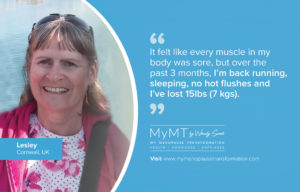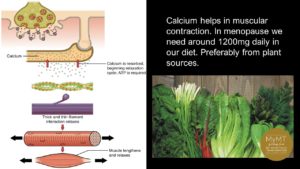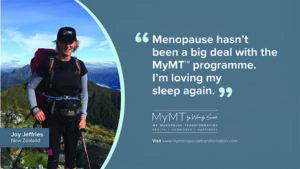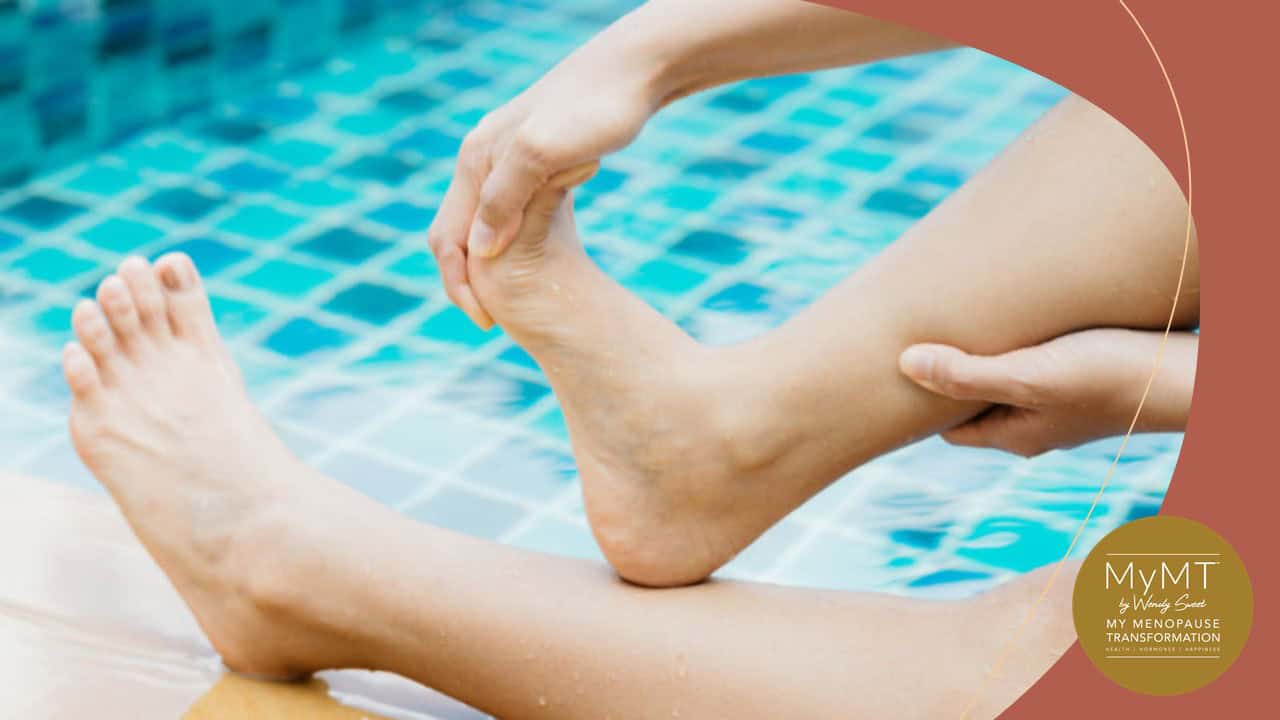Getting up in the night with leg cramps? Then you may need this remarkable mineral.
“I have an idea for your newsletter” mentioned Lesley. “I keep waking up to muscle cramps and I have no idea why. My daughter gets them too.”

This is Lesley in the photo above. She’s a runner and recently completed the MyMT™ Transform Me programme. It’s been such a privilege to get her back into running and helping her to feel better. Her story is HERE.
Understanding the Connection Between Menopause and Leg Pain
Night leg pain, also called nocturnal leg cramps, are painful, involuntary contractions or spasms of muscles in your legs, especially your calves. These usually occur when you’re in bed trying to get to sleep.
Numerous women experience these spasms or painful cramping, that seem to occur just before drifting off to sleep. For me personally they occurred when I rolled over in bed. Many a night I would get out of bed and stand on the cold bathroom floor and stretch out my hamstrings to try to alleviate the painful cramping.
Whilst leg pain usually involves your calf muscles, other muscles in your feet or thighs might cramp as well. Forcefully stretching the contracted muscle relieves the pain but the most important thing is to have a focus on the nutrients that help your muscles to relax when you are moving through your menopause transition.
I’ve taught students about muscle cramps and pain for years. They are a topic of interest for numerous sport and exercise science students. When I began to experience muscle cramps myself, I was quite surprised, because I certainly wasn’t doing the exercise that I had done in the past. Intense exercise is often associated with muscle cramps and spasms. But as I looked into the cause of them as one of the numerous symptoms of menopause (as is restless leg syndrome), I also began to understand that declining levels of oestrogen affects how muscles contract – and this in turn affects muscle cramps, especially at night … and especially those of you who are doing intense, more vigorous exercise.
Menopause Leg Cramps: Causes and Contributors
Cramps occur when a muscle is not able to relax properly (such as from a deficiency of magnesium or potassium in your diet) or for those of you who are regular exercisers, the muscles can also become irritated by a buildup of lactic acid (which can happen if you don’t rest your muscles after exercising). On top of this, dehydration can worsen both of these problems.
For those of you who have been following me for a while and reading my weekly newsletter, you will be familiar with my articles about the ageing of your blood vessels and how these change as oestrogen levels decline in menopause.
Blood vessels are known to lose some of their elasticity as women move through menopause and therefore, become ‘stiffer’. It’s known as ‘arterial’ or ‘vascular stiffness’ and is a known contributor to cardiovascular disease as women get older.
As such, this arterial stiffness may cause reduced blood flow to the muscles. This reduced blood flow may also contribute to leg cramps at night. If you are a regular exerciser, or you are on your feet all day, or you have higher inflammation in your muscles, the loss of elasticity in the arteries to your leg muscles may cause you to experience nocturnal cramps. Increased inflammatory changes in blood vessels during menopause may also contribute to increased frequency of hot flushes and night sweats too.

However, there may be other reasons for your leg cramps as well. Perhaps you are deficient in certain nutrients in your diet, especially calcium, magnesium and of course, Vitamin D?
Essential Nutrients to Combat Menopause Leg Pain At Night
To mitigate the ‘perfect storm’ between your changing oestrogen levels and the structural changes to your muscles and blood vessels during menopause, and to reduce the risk of nocturnal cramping, the key is to focus on a few nutrients in your diet.
Magnesium is an important nutrient as are Calcium and Vitamin D. These nutrients will help to prevent your nocturnal cramps (as will adequate hydration).
I often call Calcium the ‘forgotten’ mineral for muscles during menopause.
There is much emphasis given to its opposing mineral, magnesium. But calcium is equally important.
Furthermore, with postmenopausal bone health a topic of interest from the perspective of the high incidence of osteoporosis as women age, calcium is an important mineral for improving bone health.
But there’s another reason calcium is important – it acts as a crucial nerve transmitter. It is needed for the regulation of muscle contraction which is achieved by nerves firing up muscles. They do this in the presence of calcium. Because nocturnal cramps are an irregularity of the muscle contraction process, we mustn’t forget about calcium.
Why Adequate Calcium Intake is Crucial for Exercise and Recovery
Calcium helps the electrical nerve signal ‘jump’ from the nerve ending to the muscle. This is how muscles contract. They need calcium. I’ve been telling sport and exercise students this for decades.
As I’ve put up lecture slides about how muscles contract and interact with the nervous system, I always said to students, “Don’t forget about the importance of calcium in your diet, and especially don’t forget about Vitamin D and folate. Both these nutrients help calcium to be absorbed in the small intestine and you need calcium to help your muscles contract and for your recovery.”
The reason I used to say this, is because skeletal muscle contraction needs calcium. Muscles contract when an electrical current from the nerve endings sends signals for the release of calcium from inside the part of the muscle called the sarcoplasmic reticulum.
Without adequate calcium, you are going to get muscle cramps, numbness and tingling as well as dry skin and other ailments associated with menopause and post-menopause. For women like Lesley (in the banner above), who do a lot of exercise, then ensure that both magnesium and calcium intake is adequate every day. You can achieve this with a balanced diet rich in leafy greens, seeds, nuts, and dairy products, prioritising whole foods over supplements ensures better absorption and overall health benefits.

It makes sense that if we are regularly exercising, then we need calcium in our diet every day. In fact, we need 1200mg a day, day after day … because our body doesn’t make it or store it for long either. Life without adequate calcium from foods in our diet is impossible. And yes, if you are in post-menopause, you need it for your heart health as well as bone health too.
Foods that supply calcium:
Whilst dairy products contain relatively high amounts of calcium, these aren’t always tolerated in the diet, especially for those of you with food allergies or lactose intolerance or who want to lose weight. Hence, I promote lots of different foods that women can add to their diet to get adequate calcium and I have comprehensve lists in the MyMT Food Guide in all of my 12 week programmes. In many parts of the world, e.g. Okinawa, China and other Asian countries, whereby vegetarianism is a way of life, women meet their daily calcium needs, not by drinking milk, but by eating other types of foods. Three of these foods are:
- Tofu: 100 grams of tofu has about 120mg of calcium
- Spinach: 1 cup of cooked spinach has approx. 244mg of calcium.
- White beans: 1 cup of cooked white beans has approx. 160mg of calcium.

The Importance of Calcium for Hormonal Balance During Menopause
Calcium as a nutrient is most commonly associated with the formation and metabolism of bone, but it is also an important mineral in muscle contraction and this includes both the skeletal and cardiac muscles.
Calcium in the circulatory system, extracellular fluid, muscles, and other tissues is also critical for mediating blood vessel contraction and dilatation as well as enhancing nerve transmission and improving gut health. It’s an important mineral which is needed in hormone balance too.
Calcium balance in the body is maintained by actions of hormones that regulate calcium transport in the gut, kidneys, and bone. This is why calcium impacts hormone balance around the body, because all hormones work together to regulate metabolism.
When dietary intake of calcium is inadequate, or if women are eating a lot of processed foods which are highly acidic, then calcium is ‘stolen’ from bone tissue, including teeth, and taken to the general circulation to rebalance the internal environment.
Furthermore, calcium metabolism is regulated by the parathyroid hormone (PTH)–vitamin D hormonal system. This is why checking Vitamin D status as you move through menopause is important for you to do if you can.
Menopause symptoms overwhelm many women. They used to do this for me too. It can be difficult to understand why, especially if menopause hormone therapies no longer help to alleviate all of the symptoms.
But as I always say to women who join me on the online 12 week MyMT™ programmes, “it’s important to understand that our body is changing and declining oestrogen and progesterone are a normal part of menopause. Therefore, what we need to know is how to look after ourselves with evidenced lifestyle changes, when we are moving towards our biological ageing. Afterall, this is what menopause is – the gateway to our biological ageing!”
I hope you can join either of my world-class lifestyle programs sometime too.

References:
Kuo, I. Y., & Ehrlich, B. E. (2015). Signaling in muscle contraction. Cold Spring Harbor perspectives in biology, 7(2), a006023. https://doi.org/10.1101/cshperspect.a006023
Institute of Medicine, ( 2011). Dietary Reference Intakes for Calcium and Vitamin D. Washington, DC: The National Academies Press
Szent-Györgyi A. G. (1975). Calcium regulation of muscle contraction. Biophysical journal, 15(7), 707–723. https://doi.org/10.1016/S0006-3495(75)85849-8

